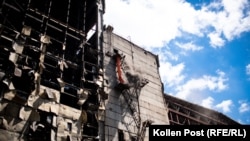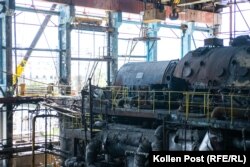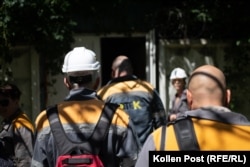The first time he felt a Russian strike on the power plant was the scariest, Ihor said: It shattered his sense of safety at the place where he's worked for over two decades.
"It didn't bring that much destruction, relatively. But when the front is far away from you, you somehow live at peace," said Ihor, a senior machinist at one of the 17 thermoelectric power plants scattered throughout Ukraine. Seven are under Russian occupation; two others have been fully destroyed. The last names of plant employees are being withheld for security reasons.
That first attack on Ihor's plant took place in October 2022, eight months into the full-scale invasion, when Russia made its first real bid to shut out the lights with winter approaching.
The strikes keep coming. An intense wave of Russian attacks on energy infrastructure in recent months has caused massive damage to the power grid and deepened the suffering Moscow is inflicting upon Ukraine.
There were four people in Ihor's section of the plant that first night, still out on the floor. "We were at our workstations. We had armored vests, we had helmets, but we weren't safe."
When the first explosion hit, the machinery around him rocked and groaned "a meter away on the blast wave," he said. "And then you think, 'If it can do that to that huge piece of machinery, what's going to happen to me?'"
Ihor grew up in the surrounding town and exhibits a measure of hometown pride in the plant, the only one of its kind and scale in the region. The 24 years he has worked there -- half of his life so far -- have been full of safety training and protocols that now seem quaint.
"The scariest thing that can happen in peacetime is some kind of explosion. We practice all of these fire-prevention trainings: who has to take what position where, what tasks fall to whom," he said. "But here, there was a situation that was impossible to take into account."
Since then, Russian strikes and the repairs that follow have become the defining feature of the job. This year, an attack in May peeled the roof off like the lid of a tin can. One of the three rockets blew up the back wall -- for the second time. The thermoelectric plant is producing no electricity.
The experience has rendered Ihor somewhat fatalistic in his attitude to a job that was never supposed to be this dangerous.
"When such a big giant attacks you, and you are much smaller than he is, you understand that it doesn't depend on you," he said. "What depends on you is which valve you are supposed to close, which valve you're not supposed to open."
Let There Be Light
Russia's relentless attacks on Ukraine's energy generation capacity have crippled the grid. Within a few weeks of the start of the full-scale invasion, over half of Ukraine's generation capacity was in Russian-occupied territory, with half of what remained taken out by air strikes. That includes 90 percent of generation at coal-fired power plants like Ihor's.
In summer, fears of freezing to death in the dark are allayed. But rolling blackouts have seized the country from end to end in recent weeks, compounding the effects of an exhausting heat wave.
On July 6, Ukrenergo, the state energy authority, reported a strike on a power plant in the Sumy region, which borders Russia in the northeast. It also flagged a new crop of fake pages for the agency appearing across social media, taking advantage of fear of further blackouts.
"Their lack of success on the front is what's causing the 'Rashists' to strike civilian targets," Ihor said, referring to a common Ukrainian wartime portmanteau of the words "Russian" and "fascist." "The fact that they're bombing power plants is, in fact, a big failure on their part."
Since that first attack, Ihor and his coworkers have gotten used to filing into one of three bomb shelters on the premises. The largest fits 600. Several jugs of water stand at the ready for a long haul underground. Old, reclaimed church pew seating faces a small bookshelf full of Orthodox Christian icons next to a cross hanging on the wall. The ventilation pipes above have been painted the yellow and blue of the Ukrainian flag.
For security reasons, the company operating the plant, DTEK, has asked that it not be identified. It is one of many that are, once again, under repair.
Closed Loop
A big part of the process consists of industrial-level cleanup. In the upper level of the plant, there are still bits of shrapnel and engines from Russian rockets lying amid fiberglass insulation that's been caved in. A demolition chute of orange buckets coughs out plumes of black smoke as rubble slides through to massive piles below the outside of the shattered wall.
DTEK facilities have been struck over 160 times since the start of the full-scale invasion in February 2022, according to the company. The director of the plant where Ihor works, Oleh, said they had lost count of how many hit this location.
Employees fear they have been locked in a "closed loop" of repairs and new strikes, said Olha Tarasyuk, a DTEK representative.
The thermoelectric facilities are all built using Soviet parts that the attacks have exhausted from throughout the allied parts of the former Eastern bloc. "What there was to get from Poland, we already got," plant director Oleh said.
As Ukraine's energy infrastructure groans, the country has stepped up imports from its Western neighbors massively, reaching almost 25,000 megawatt hours on July 22.
Like Ukrainian President Volodymyr Zelenskiy in talks with Western leaders, DTEK is lobbying heavily for greater air defense.
In the meantime, the workers are pulling "round-the-clock shifts. There's always someone here. For me, each strike, either I was here or had to come here," Ihor said. "Imagine, when others are running away from the situation, you run toward it."






